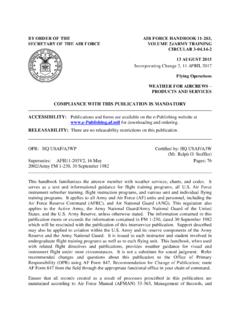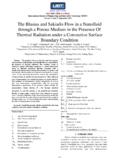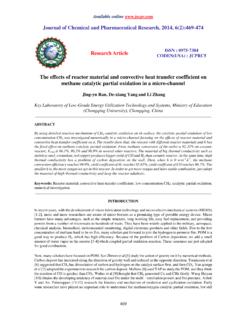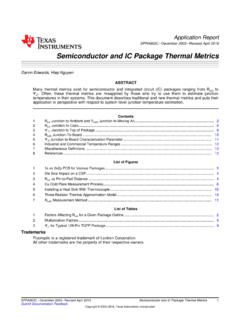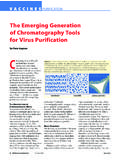Transcription of Thunderstorm Anatomy and Dynamics - WeatherAnswer.com
1 Thunderstorm Anatomy AND DYNAMICSAn OverviewPrepared by LCDR Bill NisleyMR 3421 Cloud PhysicsNaval Postgraduate School Monterey, credits: Thunderstorm Cell and Mammatus Clouds by: Michael Bath; Tornado by Daphne Zaras / NSSL; Supercell Thunderstorm by: AMOS; Wall Cloud by: Greg MichelsPAGE 2 OF IntroductionThe purpose of this paper is to present a broad overview of the various cloud structuresdisplayed during the life cycle of a Thunderstorm and the atmospheric Dynamics associatedwith each. Knowledge of atmospheric Dynamics provides for a keener understanding of thephysical processes related to the why and how certain cloud features form. Accordingly,observation of cloud features presents visual queuing of changes in the Thunderstorm Formation and Stages of DevelopmentThunderstorm development is dependent on three basic components: moisture, instability,and some form of lifting Moisture As air near the surface is lifted higher in the atmosphere and cooled, available water vaporcondenses into small water droplets which form clouds.
2 As condensation of water vapor occurs, latentheat is released making the rising air warmer and less dense than its surroundings (figure 1). The addedheat allows the air (parcel) to continue to rise and form an updraft within the developing cloud In general1, low level moistureincreases instability simply bymaking more latent heat availableto the lower mid level moisture candecrease instability in theatmosphere because moist air isless dense than dry air andtherefor is unable to evaporateprecipitation and cloud droplets aseffectively as drier of precipitation at or below cloud level cools the air within precipitation downdrafts. Thismakes the air more dense and increases downdraft velocity and Sources of Moisture. Air masses Maritime polar air massesoriginating over the Northern Pacific Oceanbring large quantities of moisture to thenorthwestern , while dry continentalpolar air from Canada frequently interactswith moist sub-tropical air from the Gulf ofMexico (figures 2 and 3).
3 Advection Low level convergence as aresult of differential heating produces muchof the Thunderstorm activity along the GulfCoast and Florida while mid level advectionof tropical moisture associated with low leveljet streams decreases stability aloft (figure3). 1 Baker, P., , NWS, San Angelo, 1999) Figure 1 Positive buoyancy / instability as a result ofcondensation and release of latent heat. (fm WW2010) Figure 2 Surface Analysis VT 11/1900z APR 99 PAGE 3 OF 13 Figure 3 GOES 9 - IR 11/1945z APR Instability Defined as: The tendency for air parcelsto accelerate when they are displaced from theiroriginal position, especially the tendency to accelerateupward after being lifted. Instability is a prerequisitefor severe weather - the greater the instability, thegreater the potential for severe , 3 Sources of increased instability include: Warm temperatures in the lowest 5,000ft andcool temperatures in the middle and upperatmosphere (10-35 kft).
4 Increased low level moisture the highmoisture content of maritime tropical airresults in high wet-bulb potential temperatures which is marginally unstable and convectiveclouds readily form consistent with afternoon heating of near-surface layers4. Generally, the greater the instability, the stronger the Thunderstorm updraft. Additionally, strongvertical wind shear may compensate for weak instability. Strong wind shear can lead to updraftrotation and rapid intensification and also helps direct precipitation fallout away from thethunderstorm updraft, allowing for longer duration thunderstorms . Surface heating and radiational cooling. Over land vs over water Land heats andcools approximately 3 times faster than areas near large bodies of water Florida,daytime surface heating of the land results inconvective currents which sets up a seabreeze. This convergence of air from both theGulf of Mexico to the west and Atlantic Oceanto the east results in 90-100 days withthunderstorms per year over Central 4 shows the effect of convergence andsubsequent destabilization of the air columnas it is forced aloft.
5 The resulting afternoonthunderstorms persist until the solar insolationdecreases enough to dissipate the thermalgradient between the land and water surfaces,causing the sea breeze to dissipate. Whilethe land surface undergoes radiational coolingafter sunset, the ocean surface retains muchof the heat gained during the day andconsequently, an off shore flow or land breeze often results. Off shore flow combined withsynoptic or monsoonal flow sets up low level convergence at sea which frequently provides thelifting required for the formation of thunderstorms at night. Additionally, as the air above the watersurface emits longwave radiation it forms a cooler layer above the warmer water. Since the airparcels nearest the ocean surface will be warmer than the layer above, an absolutely unstablesituation will exist (figure 5). 2 Branick, M.
6 , A Comprehensive Glossary of Weather Terms for Storm Spotters, NWS, Norman, OK3 A Thunderstorm is defined as severe if it produces a tornado, 3/4 inch diameter or larger hail, and/or wind gusts 50 kts (58mph) or Kessler, Edwin., Thunderstorm Morphology and Dynamics , University of Oklahoma Press, 1983, Kessler, p. 15. Figure 4 Destabilization of an initially stable columndue to lifting associated with horizontal convergence.(Kessler, p67)PAGE 4 OF 13 At higher altitudes, radiational cooling ofsaturated parcels in the upper portion ofclouds results in conditional instability. If thisoccurs in cumulus clouds (and assumingthere is convection or updrafts alreadypresent), the increased instability will mostlikely lead to enhanced cloud the upper level instability leads to the liftingof parcels beyond the level of freeconvection (LFC), thunderstorms are likelyto Lifting Lift is needed to overcome convective inhibition,sometimes referred to as a "cap.
7 " The cap is alayer of relatively warm air usually 10-15 kft aloftand forms under a large upper level ridge where the air gradually sinks and warms from the air sinks to roughly 10-15 kft, it is warmer than the air just below it (a stable condition),forming a "capping inversion." Lift is needed to push developing updrafts through the inversion ifthunderstorm development is to occur. The weaker the capping inversion, the less amount of lift isneeded to overcome Primary sources of lift: drylines and cold fronts (figure 6) terrain features differential heating which often occurswhen morning low clouds erode over aparticular area, with low clouds persistingnearby. A thermal gradient, or boundary,develops at sunrise and differentiallyheats the earth's surface. Sea breeze / Land breeze also a form of differential heating and described Vertical shear Low vs high shear.
8 The amount of vertical wind shear present is critical in determining what type of storm willform. Multicellular storms with short-lived updrafts tend to form in areas of minimal verticalshear. Low shear results in weak inflow to a storm. Consequently, the outflow reaching theground in the form a precipitation downdraft pushes the colder air of the downdraft out andaway from the storm as a gust front. This, in turn, cuts off the storm's source of warm, moistair, resulting in a storm with short-lived updrafts. Weak updrafts also allow precipitation to fallwithin it, which can eventually eliminate the updraft in its entirety. As the vertical wind shear increases, storms with persistent updrafts will be vertical wind shear results in stronger inflow to the storm. The gust front will be"held" close to the storm, and the storm will have access to the source of warm, moist air fora much longer time.
9 Therefore, the storm's updraft will tend to last longer when theenvironment has strong vertical wind shear. Precipitation will tend to fall down-wind from the s d Figure 5 Environmental (air parcel) stability relative todry and saturation adiabatic lapse rates. Figure 6 Lifting associated with a cold frontal boundary ordryline. (fm NOAA)PAGE 5 OF 13 Figure 7 Stages of Thunderstorm development: cumulus stage, mature stage, dissipating stage. (fm Burroughs, p. 49)updraft rather than through the updraft, which enables the updraft to continue for a relativelylonger period of time6. Low level jet streams7 Nocturnal (non-frontal) thunderstorms in the Midwest are typically associated with a low leveljetstream oriented N-S or NE-SW. Boundary layer low-level jets are frequently observed at night along the western portions ofthe Great Plains with maximum winds often exceeding 25 m/s within 500m of the ground. Astrong west to east horizontal pressure gradient along the lee of the Rocky Mountains with asustained flow of air northward from the Gulf of Mexico generally occurs with thisphenomena.
10 While the presence of a low-level jet is not required for thunderstorms to occur,the downstream convergence associated with the jet core explains the increased potentialfor nocturnal Thunderstorm development. This low-level jetstream has been described as anatmospheric analog to the Gulf Stream current and its diurnal variation is not Stages of Development8 (figure 7) Cumulus Stage Characterized by an updraft throughout most of the cell, which causes the cloud togrow. Drier air flows in through the sides and the top, and mixes with the updraft. With continuedupward motion a large amount of water condenses and eventually falls as precipitation. The cumulusstage typically lasts 10-15 Mature Stage Characterized by the presence of downdrafts and updrafts, as water droplet sizeexceeds the capacity for the updraft to suspend the droplets, the droplets begin to fall. Precipitationthen initiates the downdraft due to viscous drag (of the water on the air) and evaporative cooling ofthe air.


